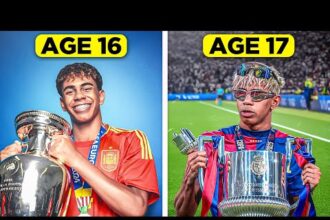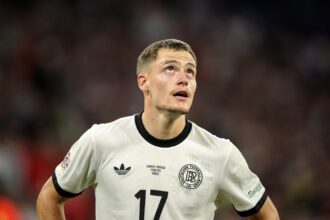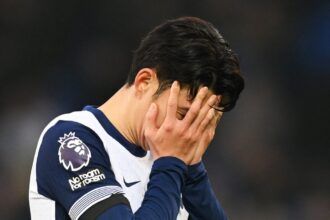Manchester City’s struggles cannot come as a surprise to anybody by now but the latest demonstration against Liverpool highlights how far they have fallen, and brings into focus the question of whether they will be able to rise again.
The 2-0 defeat at the Etihad Stadium means City are now 20 points behind Liverpool in the Premier League, the furthest they have been from top spot at the end of a day since July 2020, when they were 21 points behind the Reds.
Advertisement
That came at the end of the 2019-20 season, which was, until recently, considered the low point of Guardiola’s City reign. Then, their instability meant they would beat most teams but come unstuck on the counter-attack every now and again. They finished 18 points behind Liverpool but kept the most clean sheets in the league and scored by far the most, 102. Oh, how they must yearn for those flaws now.
Things turned out all right, too, given they won the next four Premier League titles, but the wheels have come off now and since the end of October, they have lost 14 of their 27 matches in all competitions.
And given the disastrous nature of some of those defeats (and even the 3-3 draw with Feyenoord), this latest poor performance is nowhere near the worst.
But its position as the weekend’s big match, coupled with comparisons to former clashes between the two sides, does mean that yet more scrutiny is coming City’s way.
The difference between these two giants in 2019 was 11 millimetres: John Stones’s goal-line clearance helped City pick up a 2-1 victory in possibly the highest-quality match in Premier League history. It was Liverpool’s only defeat in the league that season and City were still four points behind them at full time, but won their final 14 games in a row to seal the title on the final day.
Three years later, a similar scenario played out, with City clinching it thanks to a final-day comeback from 2-0 down against Aston Villa. During that season, City and Liverpool played out two 2-2 draws, the first at Anfield a rival to the earlier clash for the highest-quality league match of the modern era, the second a more chaotic display of both sides’ quality.
This is not to say Liverpool have maintained their level throughout this period. Even in the great Jurgen Klopp era, they had seasons when they were nowhere near the title picture but they bounced back at times and that is the challenge that faces this City team now, beyond the more immediate need to clinch a top-four (or top-five) finish and get back into the Champions League.
Advertisement
A month ago, Guardiola said, “We are an old team,” when discussing their problems with counter-attacks and measures have already been taken to address that. The average age of their starting line-up on Sunday was their joint-youngest in a league match under Guardiola since, perhaps coincidentally, perhaps not, July 2020, the end of that rare fallow season.
“Savinho and (Jeremy) Doku and all the young players — except Kevin (De Bruyne) and Nathan (Ake) — we were a so, so young team that will be the future of this club,” Guardiola said after Sunday’s defeat.
Winter signings Abdukodir Khusanov, 20, and Nico Gonzalez, 23, were used here, meaning that Doku, who arrived 18 months ago, and Savinho, who arrived in the summer, feel like old stagers, but they are 22 and 20.
Nico Gonzalez is likely to be a central part of the next iteration of Pep Guardiola’s Manchester City side (Alex Pantling/Getty Images)
Josko Gvardiol has endured a tough time this season — and yet still has been one of City’s bright spots — and is 23. Phil Foden, who is struggling more than most at the moment, is still just 24. So is Erling Haaland.
When another January arrival, Omar Marmoush, cannot be considered young at 26, despite the glaring examples of De Bruyne (33) and Ilkay Gundogan (34), as well as Mateo Kovacic, (30, but cited when Guardiola discussed his side’s age), it shows that things are moving in the right direction, and the rebuild will continue this summer.
But what they are still short of is quality. Without Haaland on Wednesday in Madrid, they had, basically, nothing. Their attacks would break down as soon as they reached the final third.
Against Liverpool there was more, but only judged against that very low bar. Doku attempted 19 take-ons, which is the most in the league this season, and completed 13, meaning he gave some of the Liverpool defenders a torrid afternoon, but there was usually another one on hand to mop up the danger. Savinho was threatening, too, but nothing came of his drives either.
Advertisement
Nothing is coming off, with Foden giving the ball away repeatedly and De Bruyne’s decline becoming steeper and steeper. Things like that have led to some wondering whether this City side are being left behind.
There has been talk recently, including on the BBC Sport website on Sunday morning, about the league evolving beyond the limits of City and Guardiola’s playing style. Teams are too fast and too physical, it is reasoned, and City’s more patient approach is becoming outdated.
The conclusion that City are at risk of becoming stuck in the past is tempting because the manager’s best available answer to his side’s struggles is to ask for less speed and more passes, but it would be difficult to bet against them proving that their increasingly unique style still works once they get the players in to play it efficiently.
After all, teams were always faster and more physical than them before, it is just that the gap is so big now because Rodri is not there and the others have aged. Add Rodri back into the midfield alongside Nico and a summer replacement for De Bruyne and/or Gundogan and it is easier to imagine them competing much more than they have been.
It requires Doku and Savinho to develop a cutting edge, and it is a similar story for Marmoush, but the wingers’ efforts were regarded as a huge positive for Guardiola.
“I don’t know how many times we arrived to the byline, for nine years it’s been the target for my team,” he said. “How many times we arrived in the byline is a dream for what we want to do, but the next thing we struggled, for the amount of time we arrived to the byline, in the six-yard box we did not create much, although it is not easy.”
Standards are lower these days, that is for sure, but knowing Guardiola — who says he is effectively addicted to the job — they simply will not be once the dust has settled on this seemingly never-ending cycle of disappointment, because City have already started the process of moving on.
Advertisement
At the back, Khusanov is a very rough diamond but he is far better than his disastrous debut against Chelsea suggests, while 19-year-old Vitor Reis, their other January signing, is one of the hottest young centre-backs around. That back line might need a more immediately ready reinforcement in the summer, given Stones and Ake’s injury problems, but City will not go quietly.
Getting back to their very best is a big ask because, as can be appreciated better following the past few months, that high point of trebles (domestic and ‘proper’) and quadruples was truly incredible. It might never be reached by anybody.
They have a long way to go to get back to even the previous standards required of a title winner, given how uncompetitive they have been. Some major changes are needed in the summer but, in the case of some of the current strugglers — Foden, Ruben Dias and Bernardo Silva — it is possible to imagine them back at a much higher level once unburdened by the relentless negativity of this season and surrounded by fresh energy.
Maybe the process of replacing legends — De Bruyne, and possibly Gundogan, Ederson and even Bernardo himself — proves to be too much to do in one go, and maybe next season is a bridge too far, too.
But they cannot keep being as bad as this, can they?
(Top photo: Shaun Botterill/Getty Images)









